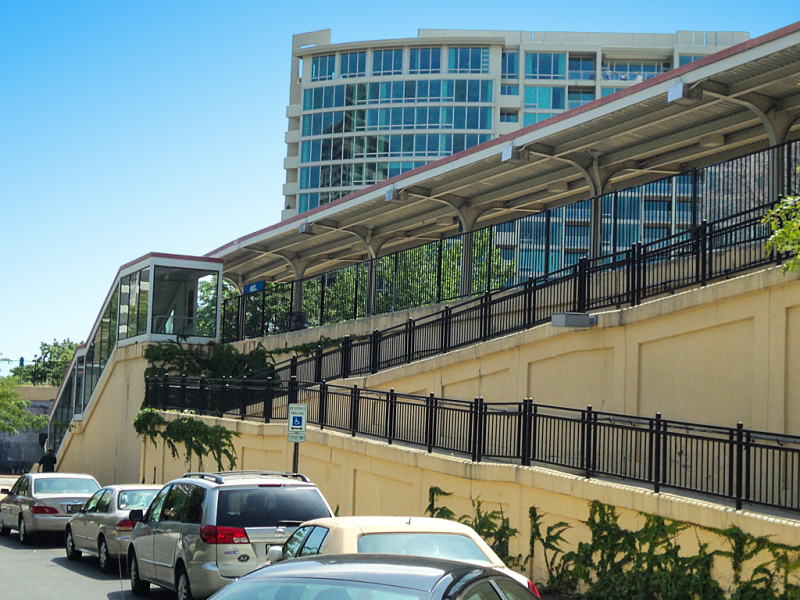
The Davis Street CTA station in Evanston, IL is wheelchair accessible, one of several ways the city has integrated accessibility into its development near transit. Photo via Metra.
On many transit-oriented development (TOD) projects, accommodations for people with disabilities are not considered until after a project is substantially planned and even built. At best, this means project leads have to go back and retrofit stations and their surrounding development to accommodate people with limited mobility. At worst, it means these places are not accessible for people with disabilities and older adults.
This is a huge missed opportunity. Incorporating diverse voices from the start of a TOD project can help it be more accessible for everyone, no matter their mobility needs. And more accessible means the area will be attractive to more workers, more transit riders, more homebuyers, and more shoppers.
That philosophy is at the core of the work of the National Center for Mobility Management, a project funded by the Federal Transit Administration that helps communities adopt transportation strategies and mobility options that empower people to live independently, and to advance health, economic vitality, self-sufficiency, and community. The Center supports the development of integrated mobility networks in states, regions, and communities that include a diverse range of innovative transit services and the participation of stakeholders in coordinated planning.
“We work to make sure there’s not just access to one particular stop or station, but a whole connected network for people with disabilities,” says Judy Shanley, Co-Director of the National Center for Mobility Management and Director of Easterseals, a network that provides services, education, outreach, and advocacy to help people living with autism and other disabilities live, learn, work and play in America’s communities. “That usually takes a whole lot of people and agencies working together, and that’s the role we play—to foster those partnerships.”
A big part of the Center’s focus is bringing people with disabilities to the planning table early. “If you build in the needs of diverse riders from the get-go, you don’t have to add it on afterward,” Shanley explains.
The Center helps communities use a variety of strategies to engage people with disabilities as well as older adults. Those strategies include partnering with social services organizations, ensuring that TOD planning meetings and forums are accessible, hiring people with disabilities for key decision-making positions within the TOD effort, and communicating activities regularly with organizations representing individuals with disabilities and older adults.
“TOD planners also need to learn more about the mobility needs of diverse community members,” Shanley adds. Planners should continuously assess the extent to which people with disabilities and older adults are engaged the TOD process. One tool that can help them do that is TransitPlanning4All, a collaborative project of FTA and the U.S. Department of Health and Human Services that helps communities nationwide in adopting proven, sustainable, scalable, and replicable models that include participation of people with disabilities and older adults in the design and implementation of coordinated transportation systems that are responsive to their needs.
One example of a city that has done it well is Evanston, IL. With help from the U.S. Department of Health and Human Services’ Administration for Community Living, Evanston invited people with disabilities and older adults to join the city’s planning commission as advisors. In addition, they created a permanent staff position for an Equity Officer whose role is to make sure the city considers the needs of people with disabilities and older adults.
“It’s a great example of a systemic solution to this issue, and making sure accessibility is integrated into the city’s processes permanently,” Shanely says.
Other projects of the National Center for Mobility Management include its Rides to Wellness program, which helps healthcare providers and public transportation staff collaborate to improve health, increase access to care, and reduce healthcare costs. And as part of the Coordinating Council on Access and Mobility, Shanley and her team unites accessibility efforts across multiple federal agencies.
“People with disabilities have different needs than the average rider,” Shanley says. “But making a transportation system that works for them is part of making a transportation system that works, period. We all prosper when systems are inclusive and accessible TOD is part of making that happen.”
Learn more about the National Center for Mobility Management and their work at nationalcenterformobilitymanagement.org.